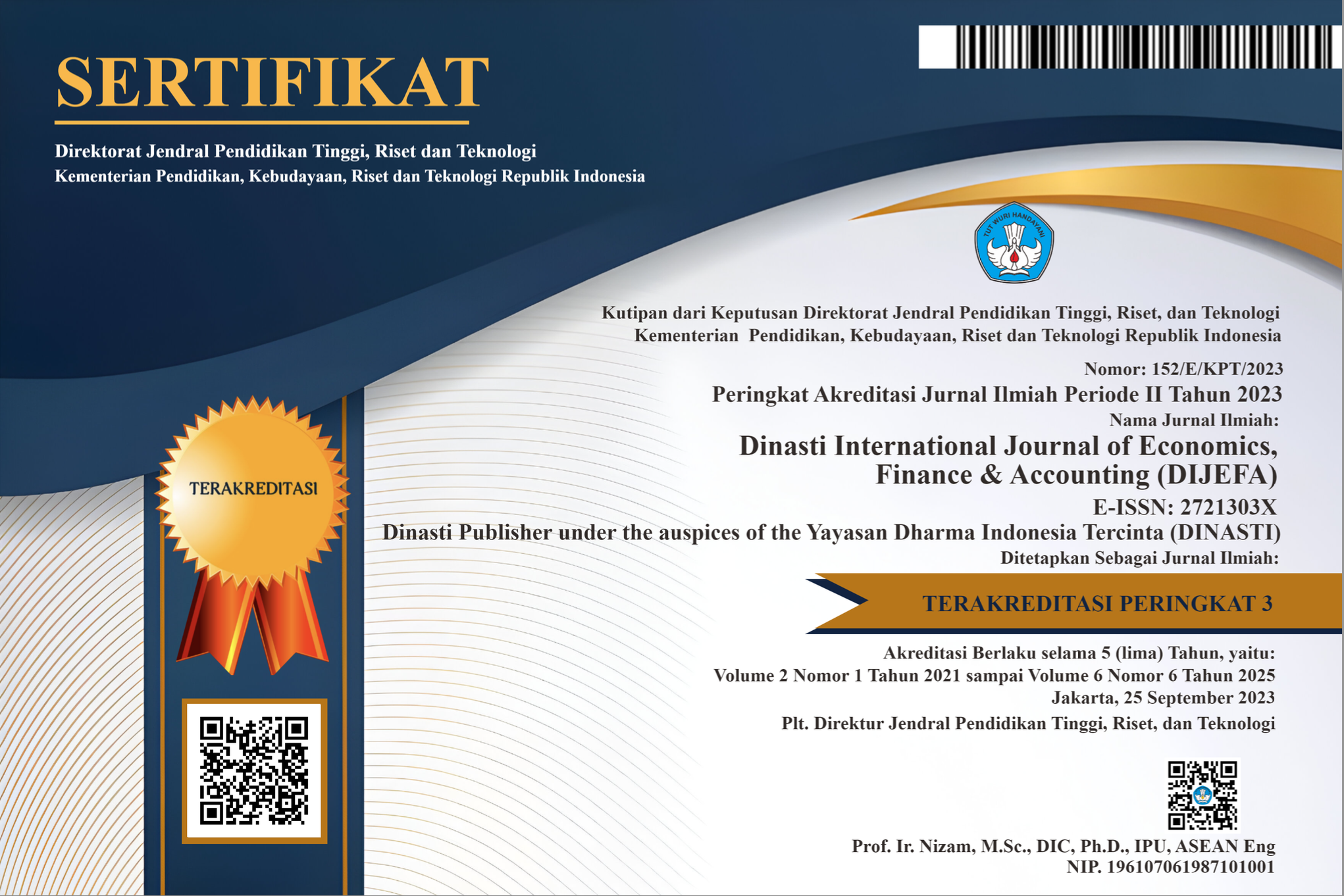Readyness for Biodiversity Accounting Disclosure in Corporations Towards Future Hilirization
DOI:
https://doi.org/10.38035/dijefa.v6i1.3893Keywords:
Hilirization, Biodiversity Accounting, Sustainability reporting, quantitative approach, sustainability futureAbstract
This study examines biodiversity accounting in Indonesia's mining and energy sectors, highlighting the challenges and readiness of companies to support the downstream agenda. Despite the increasing importance of biodiversity for sustainability, issues such as transparency in environmental cost reporting and compliance with regulations persist. Using a qualitative approach through textual analysis of sustainability reports from 60 companies listed on the Indonesia Stock Exchange for 2022-2023, the research identifies key themes related to biodiversity impacts and company actions. The findings reveal that these companies exhibit varying levels of readiness in facing downstream initiatives, with a significant gap between corporate commitments to biodiversity protection and actual implementation. Recommendations for future studies emphasize the importance of integrating advanced technologies, stakeholder engagement, and the role of policy frameworks in enhancing biodiversity management. This research contributes to understanding how companies can align their practices with sustainable development goals, ensuring economic growth while safeguarding biodiversity.
References
Abram, M. D., Mancini, K. T., & Parker, R. D. (2020). Methods to Integrate Natural Language Processing Into Qualitative Research. International Journal of Qualitative Methods, 19, 1–6. https://doi.org/10.1177/1609406920984608
Al-Eisawi, D. (2022). A design framework for novice using grounded theory methodology and coding in qualitative research: Organisational absorptive capacity and knowledge management. International Journal of Qualitative Methods, 21, 16094069221113552.
Asiaei, K., Bontis, N., Alizadeh, R., & Yaghoubi, M. (2022). Green intellectual capital and environmental management accounting: Natural resource orchestration in favor of environmental performance. Business Strategy and the Environment, 31(1), 76–93. https://doi.org/10.1002/bse.2875
Asmy, A. E., Rauf, A., Rahmawaty, Badaruddin, & Khasanah, U. (2024). Reformulation of Persimmon Value-Added Model: Product Downstream Development Strategy for Farmers in East Java, Indonesia. In Resources (Vol. 13, Issue 3). https://doi.org/10.3390/resources13030034
Aureli, S., Del Baldo, M., Lombardi, R., & Nappo, F. (2020). Nonfinancial reporting regulation and challenges in sustainability disclosure and corporate governance practices. Business Strategy and the Environment, 29(6), 2392–2403. https://doi.org/10.1002/bse.2509
Azizi, S., Sotoudehnejad, F., & Yazdinejad, E. A. (2023). Environmental Accounting?: An Effort to Develop for Identifying and Ranking Green Accounting Indicators. International Journal of Finance and Managerial Accounting, 8(30), 309–324. https://ijfma.srbiau.ac.ir/article_21627.html%0Ahttps://ijfma.srbiau.ac.ir/article_21627_a3631a5facf757a66424b748c2388ff7.pdf
Blanco-Zaitegi, G., Álvarez Etxeberria, I., & Moneva, J. M. (2022). Biodiversity accounting and reporting: A systematic literature review and bibliometric analysis. Journal of Cleaner Production, 371(August). https://doi.org/10.1016/j.jclepro.2022.133677
Boiral, O. (2016). Accounting for the Unaccountable: Biodiversity Reporting and Impression Management. Journal of Business Ethics, 135(4), 751–768. https://doi.org/10.1007/s10551-014-2497-9
Boiral, O., & Heras-Saizarbitoria, I. (2020). Sustainability reporting assurance: Creating stakeholder accountability through hyperreality? Journal of Cleaner Production, 243, 1–17. https://doi.org/10.1016/j.jclepro.2019.118596
Cipullo, N. (2016). Biodiversity Indicators: The Accounting Point of View. Procedia Economics and Finance, 39(November 2015), 539–544. https://doi.org/10.1016/s2212-5671(16)30297-0
Cordella, M., Gonzalez-Redin, J., Lodeiro, R. U., & Garcia, D. A. (2022). Assessing impacts to biodiversity and ecosystems: understanding and exploiting synergies between Life Cycle Assessment and Natural Capital Accounting. Procedia CIRP, 105, 134–139. https://doi.org/https://doi.org/10.1016/j.procir.2022.02.023
Corey, B., Andersen, A. N., Legge, S., Woinarski, J. C. Z., Radford, I. J., & Perry, J. J. (2020). Better biodiversity accounting is needed to prevent bioperversity and maximize co-benefits from savanna burning. Conservation Letters, 13(1), 1–13. https://doi.org/10.1111/conl.12685
Dhar, B. K., Sarkar, S. M., & Ayittey, F. K. (2022). Impact of social responsibility disclosure between implementation of green accounting and sustainable development: A study on heavily polluting companies in Bangladesh. Corporate Social Responsibility and Environmental Management, 29(1), 71–78. https://doi.org/10.1002/csr.2174
Geneletti, D., Beinat, E., Chung, C. J. F., Fabbri, A. G., & Scholten, H. J. (2003). Accounting for uncertainty factors in biodiversity impact assessment: Lessons from a case study. Environmental Impact Assessment Review, 23(4), 471–487. https://doi.org/10.1016/S0195-9255(03)00045-3
Holt, N. L., Pankow, K., Ormond, I., Jørgensen, H., Deal, C. J., & Pynn, S. R. (2022). Grounded theory. International Review of Sport and Exercise Psychology, 15(1), 199–225.
King, S., Vardon, M., Grantham, H. S., Eigenraam, M., Ferrier, S., Juhn, D., Larsen, T., Brown, C., & Turner, K. (2021). Linking biodiversity into national economic accounting. Environmental Science and Policy, 116(November 2020), 20–29. https://doi.org/10.1016/j.envsci.2020.10.020
Maione, G., Cuccurullo, C., & Tommasetti, A. (2023). Biodiversity accounting: a bibliometric analysis for comprehensive literature mapping. Sustainability Accounting, Management and Policy Journal. https://doi.org/10.1108/sampj-04-2022-0214
Makri, C., & Neely, A. (2021). Grounded theory: A guide for exploratory studies in management research. International Journal of Qualitative Methods, 20, 16094069211013654.
Maroun, W., & Atkins, J. (2021). A Practical Application of Accounting for Biodiversity: The Case of Soil Health. Social and Environmental Accountability Journal, 41(1–2), 37–65. https://doi.org/10.1080/0969160X.2020.1819360
Remme, R. P., Hein, L., & Van Swaay, C. A. M. (2016). Exploring spatial indicators for biodiversity accounting. Ecological Indicators, 70, 232–248. https://doi.org/10.1016/j.ecolind.2016.06.024
Renaldo, N., Sevendy, T., & Simatupang, H. (2022). the Role of Environmental Accounting in Improving Environmental Performance Through Csr Disclosure. Business Management and Accounting (ICOBIMA), 1(1), 17–23.
Roberts, L., Hassan, A., Elamer, A., & Nandy, M. (2021). Biodiversity and extinction accounting for sustainable development: A systematic literature review and future research directions. Business Strategy and the Environment, 30(1), 705–720. https://doi.org/10.1002/bse.2649
Sabowo, H. K., & Siswanto, B. (2023). Legal Aspects of the Export Prohibition of Raw Nickel Related to Increasing Hilirization in Indonesia BT - Proceedings of the International Conference On Law, Economics, and Health (ICLEH 2022). 733–743. https://doi.org/10.2991/978-2-38476-024-4_74
Sadri, N., & Hossein Ranjbar, M. (2024). Developing a Model for Clean Production in Management Accounting Based on Grounded Theory and Thematic Analysis. International Journal of Finance and Managerial Accounting, 9(35), 173–188.
Schulze, K., Malek, Ž., & Verburg, P. H. (2020). The Impact of Accounting for Future Wood Production in Global Vertebrate Biodiversity Assessments. Environmental Management, 66(3), 460–475. https://doi.org/10.1007/s00267-020-01322-4
Senn, J., & Giordano-Spring, S. (2020). The limits of environmental accounting disclosure: enforcement of regulations, standards and interpretative strategies. Accounting, Auditing and Accountability Journal, 33(6), 1367–1393. https://doi.org/10.1108/AAAJ-04-2018-3461
Skouloudis, A., Malesios, C., & Dimitrakopoulos, P. G. (2019). Corporate biodiversity accounting and reporting in mega-diverse countries: An examination of indicators disclosed in sustainability reports. Ecological Indicators, 98(May 2018), 888–901. https://doi.org/10.1016/j.ecolind.2018.11.060
Stough, L. M., & Lee, S. (2021). Grounded theory approaches used in educational research journals. International Journal of Qualitative Methods, 20, 16094069211052204.
Syarifuddin, S., & Damayanti, R. A. (2020). Biodiversity accounting: uncover environmental destruction in Indonesia. Social Responsibility Journal, 16(6), 809–825. https://doi.org/10.1108/SRJ-11-2018-0291
Tiwari, K., & Khan, M. S. (2020). Sustainability accounting and reporting in the industry 4.0. Journal of Cleaner Production, 258, 120783. https://doi.org/10.1016/j.jclepro.2020.120783
Traxler, A. A., Schrack, D., & Greiling, D. (2020). Sustainability reporting and management control – A systematic exploratory literature review. Journal of Cleaner Production, 276, 122725. https://doi.org/10.1016/j.jclepro.2020.122725
Tsalis, T. A., Malamateniou, K. E., Koulouriotis, D., & Nikolaou, I. E. (2020). New challenges for corporate sustainability reporting: United Nations’ 2030 Agenda for sustainable development and the sustainable development goals. Corporate Social Responsibility and Environmental Management, 27(4), 1617–1629. https://doi.org/10.1002/csr.1910
Weir, K. (2019). The logics of biodiversity accounting in the UK public sector. Accounting Forum, 43(3), 348–379. https://doi.org/10.1080/01559982.2019.1605873
Downloads
Published
How to Cite
Issue
Section
License
Copyright (c) 2025 Simon Nisja Putra Zai, Yuni Pristiwati Noer Widianingsih

This work is licensed under a Creative Commons Attribution 4.0 International License.
Authors who publish their manuscripts in this journal agree to the following conditions:
- The copyright on each article belongs to the author(s).
- The author acknowledges that the Dinasti International Journal of Economics, Finance & Accounting (DIJEFA) has the right to be the first to publish with a Creative Commons Attribution 4.0 International license (Attribution 4.0 International (CC BY 4.0).
- Authors can submit articles separately, arrange for the non-exclusive distribution of manuscripts that have been published in this journal into other versions (e.g., sent to the author's institutional repository, publication into books, etc.), by acknowledging that the manuscript has been published for the first time in the Dinasti International Journal of Economics, Finance & Accounting (DIJEFA).


























































